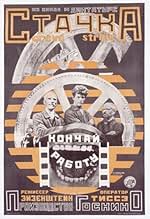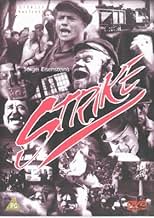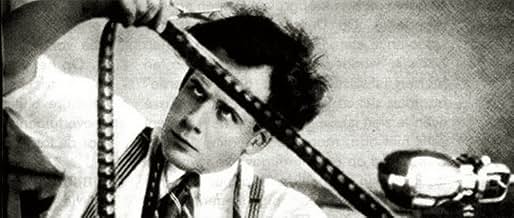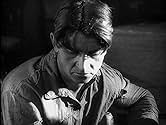IMDb RATING
7.6/10
9.2K
YOUR RATING
A group of oppressed factory workers go on strike in pre-revolutionary Russia.A group of oppressed factory workers go on strike in pre-revolutionary Russia.A group of oppressed factory workers go on strike in pre-revolutionary Russia.
Leonid Alekseev
- Factory Sleuth
- (uncredited)
Daniil Antonovich
- Worker
- (uncredited)
Pyotr Malek
- Police Spy
- (uncredited)
Misha Mamin
- Baby Boy
- (uncredited)
Pavel Poltoratskiy
- Stockholder
- (uncredited)
Featured reviews
Eisenstein's most purely enjoyable film, possibly because the theorems are more lifelike. In many ways a comedy, as the villains (military, police, factory owners, underworld scabs) are caricatured and dehumanised, which makes the eventual horrors all the more shocking. The workers are, of course, idealised, but their paradise of laziness seems odd for a Communist work.
Montage is the thing, as ever with Eisenstein, both in terms of connecting images to create startling insights, and in making tense, exciting and inevitable the action; but there is an astonishing attention to compositional detail too, most haunting perhaps being the empty, abandoned, impotent, machine-heavy factories, or the vast-stepped drawing rooms of the bloated capitalists.
Montage is the thing, as ever with Eisenstein, both in terms of connecting images to create startling insights, and in making tense, exciting and inevitable the action; but there is an astonishing attention to compositional detail too, most haunting perhaps being the empty, abandoned, impotent, machine-heavy factories, or the vast-stepped drawing rooms of the bloated capitalists.
Sergei Eisenstein's "Strike", like his more well-known films, is interesting and contains some memorable imagery. The story is worthwhile in itself, and it repays careful attention because of the considerable detail that is shown using Eisenstein's distinctive approach. It lacks any particularly interesting characters, but then, so did "Battleship Potemkin". Only an occasional lack of polish sets this apart from Eisenstein's later films.
The story starts with the situations that provoke the strike, and then follows developments on both sides of the dispute. It becomes surprisingly involved for what seems at first to be a simple confrontation. There is quite an assortment of situations, settings, and characters. On occasion, the images are overdone, occasionally even off-putting, but you can already see the creative use of imagery that Eisenstein would later use so effectively.
"Strike" will probably be of interest mainly to those who already appreciate Eisenstein's films, but it is worth seeing. It is really only a cut below "Potemkin", which itself, though generally the most-praised of his films, might actually be surpassed by some of his later works. In any case, "Strike" displays the same kind of style, and has several of the characteristics of the fine classics that were to come.
The story starts with the situations that provoke the strike, and then follows developments on both sides of the dispute. It becomes surprisingly involved for what seems at first to be a simple confrontation. There is quite an assortment of situations, settings, and characters. On occasion, the images are overdone, occasionally even off-putting, but you can already see the creative use of imagery that Eisenstein would later use so effectively.
"Strike" will probably be of interest mainly to those who already appreciate Eisenstein's films, but it is worth seeing. It is really only a cut below "Potemkin", which itself, though generally the most-praised of his films, might actually be surpassed by some of his later works. In any case, "Strike" displays the same kind of style, and has several of the characteristics of the fine classics that were to come.
Not Eisensteins most famous film, but it was his first and it's important in the history of cinema. The montage is brilliant and the inventive camerawork alone make it endlessly important. A routine story about workers striking put against the satire of the aristocracy, it seems most of the Russian silent films were like this, but the story isn't whats important in these films, it's the camera use. Eisenstein, Pudovkin, Kuleshov, these filmmakers are possibly the most important group of directors ever.
It takes place during the 1912 Factory Strike in Russia. This was the brilliant debut of Sergei Eisenstein which introduced the idea of montage. Done before Potemkin, Stachka/Strike(1925) is a film about the struggle of the working class against the Tsar. The film showed of things to come for the career of Eisenstein. This was to be part of a series of films concerning the events that led to the 1917 Revolution. He shows the working class as the main protagonist in Strike. Was co-written by frequent co-writer Grigori Aleksandrov.
Stachka and Battleship Potemkin would be the only films in which Eisenstein would have complete artistic control. Like Potemkin, it also features a grand massacre sequence. Eisenstein's direction is nothing short of first class. October(1927) can be looked upon as a sequel to Strike. The images of this is an example of why the silent period was the last truly great era of visual filmmaking. Strike would be the first of many great movies from a master artist. A fine scene is the superimposition of a slaughtered bull over a scene of massacred workers.
Stachka and Battleship Potemkin would be the only films in which Eisenstein would have complete artistic control. Like Potemkin, it also features a grand massacre sequence. Eisenstein's direction is nothing short of first class. October(1927) can be looked upon as a sequel to Strike. The images of this is an example of why the silent period was the last truly great era of visual filmmaking. Strike would be the first of many great movies from a master artist. A fine scene is the superimposition of a slaughtered bull over a scene of massacred workers.
This is an impressive looking piece of Communists propaganda, that glorify the common worker, from Russian movie-making pioneer Sergei M. Eisenstein.
It's one of Eisenstein's first movies, which also means that he was experimenting a lot in the movie, with many different compositions and with fantastic fast editing that give the movie pace and make the sequences more exciting. Some of the sequences are highly creative and artistic looking, with great cinematography and camera-angels. It makes "Stachka" real eye-candy to watch. It's a real innovative movie and by watching it you realize that there was a real craftsman at work. It's an absolutely brilliantly directed movie!
Of course if you're looking for a movie with a good story and compelling characters, look further. The movie itself is pretty simple with its story and uses deliciously stereotypical characters, such as the capitalistic, fat, cigar smoking and drinking factory owners. The movie uses so many stereotypes that the movie intentionally also works out as an humorous movie. It's very welcome, since the movie in general in its story is very serious and tries to send out a message.
The story is perhaps easier to follow than in most other Eisenstein movies. It's a very simple story that on paper sounds to weak and uninteresting to fill a 90+ movie with. Yet the movie never bores and always remains interesting and 'enjoyable' to follow, also not in the least thanks to the rapid editing that makes sure none of the sequences go on for too long and allow the sequences to speak for itself, rather then relying on the actors their performances or title-cards.
An essential viewing for movie-lovers!
9/10
http://bobafett1138.blogspot.com/
It's one of Eisenstein's first movies, which also means that he was experimenting a lot in the movie, with many different compositions and with fantastic fast editing that give the movie pace and make the sequences more exciting. Some of the sequences are highly creative and artistic looking, with great cinematography and camera-angels. It makes "Stachka" real eye-candy to watch. It's a real innovative movie and by watching it you realize that there was a real craftsman at work. It's an absolutely brilliantly directed movie!
Of course if you're looking for a movie with a good story and compelling characters, look further. The movie itself is pretty simple with its story and uses deliciously stereotypical characters, such as the capitalistic, fat, cigar smoking and drinking factory owners. The movie uses so many stereotypes that the movie intentionally also works out as an humorous movie. It's very welcome, since the movie in general in its story is very serious and tries to send out a message.
The story is perhaps easier to follow than in most other Eisenstein movies. It's a very simple story that on paper sounds to weak and uninteresting to fill a 90+ movie with. Yet the movie never bores and always remains interesting and 'enjoyable' to follow, also not in the least thanks to the rapid editing that makes sure none of the sequences go on for too long and allow the sequences to speak for itself, rather then relying on the actors their performances or title-cards.
An essential viewing for movie-lovers!
9/10
http://bobafett1138.blogspot.com/
Did you know
- TriviaStrike (Russian: La grève (1925)) is a Soviet silent propaganda film edited and directed by Sergei Eisenstein. Originating as one entry out of a proposed seven-part series titled "Towards Dictatorship of the Proletariat," Strike was a joint collaboration between the Proletcult Theatre and the film studio Goskino. As Eisenstein's first full-length feature film, it marked his transition from theatre to cinema, and his next film Le cuirassé Potemkine (1925) (Russian: Bronenosets Potyomkin) emerged from the same film cycle.
- GoofsThe story is set in 1903. Throughout the film, automobiles from the 1920s appear on streets. One is the 1920s auto that the worker (who stole the administrators' posted reply to workers' demands) tried to use to escape police goons during a nighttime rainstorm. When upper-class women appear, they are wearing contemporary 1920s fashions, and the popular music that's on the sound track is also from the 1920s.
- Quotes
Title Card: At the factory, all is calm. BUT. The boys are restless.
- Alternate versionsThe film was restored at Gorky Film Studio in 1969.
- ConnectionsEdited into Ten Days That Shook the World (1967)
- How long is Strike?Powered by Alexa
Details
- Runtime1 hour 22 minutes
- Color
- Sound mix
- Aspect ratio
- 1.33 : 1
Contribute to this page
Suggest an edit or add missing content




























